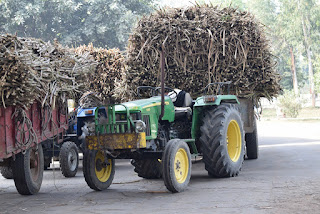Written by Jen Henrie and Dani Hanson
This morning we left New Delhi for Agra. Along the way we stopped at a sugarcane mill. Sugarcane is a major crop in India. The mill is a cooperative with more than 40,000 members from almost 400 separate villages. The mill has a crushing capacity of 1,600 tons per day. Once again, the Indian people greeted us with incredible hospitality. We received flower garlands with white, orange, yellow and red flowers that signify respect for honored guests. During the briefing with the executives, we were served ample portions of fried vegetables, chips, tea, sweetened cashew paste, and sugarcane juice.
This morning we left New Delhi for Agra. Along the way we stopped at a sugarcane mill. Sugarcane is a major crop in India. The mill is a cooperative with more than 40,000 members from almost 400 separate villages. The mill has a crushing capacity of 1,600 tons per day. Once again, the Indian people greeted us with incredible hospitality. We received flower garlands with white, orange, yellow and red flowers that signify respect for honored guests. During the briefing with the executives, we were served ample portions of fried vegetables, chips, tea, sweetened cashew paste, and sugarcane juice.
The cooperative was started with support from the government
and the government still plays a large role in the organization
Sugarcane takes 8-10 months to grow and producers often
harvest two or three crops from one planting. Sugarcane is grown best in a mix
of clay and sandy soil. On average producers harvest 30 tons of cane per acre.
Producers can buy seed and other inputs from the cooperative and these inputs
are often loaned to producers with no interest.
Harvest generally begins in November and runs through the
end of April. Most producers transport the cane to the mill or one of the
cooperatives’ satellite locations to be weighed. Producers are paid based on
the weight of the product. It is important that the cane is processed as soon
as possible after harvest. If it sits, the juice dries out and the cane becomes
lighter resulting in less sugar and lower prices for the farmers.
 |
| Raw pulp coming out of the crusher |
 |
| Sending the sugar out for delivery |

 |
| Rebecca Christmas sampling some of the raw sugar coming off the line |
They package the sugar in 50 kg bags that are sold through a
purchasing agency. The agency turns around and sells to end-users. We also had
the opportunity to see a warehouse where the bags can be stored. There was
7,000 tons of sugar stored in just one warehouse we saw. We finished the visit
taking photos with many of the mill’s workers and executives, as well as the
government’s managing director, Jitendra Kumar Garg.
We stopped for lunch at a small hotel in a relatively rural
area, the Country Inn. Alongside a Hindu shrine in the lobby were posters
asking guests to leave feedback on Facebook and Trip Advisor, showing us how
modernization and technology are reaching far into this country. We boarded the
bus to continue our trip to Agra, with plans to visit markets this evening for
jewelry, textiles, and stone. Raj began preparing us for our visit to the Taj
Mahal tomorrow by telling us the story of Moghul emperor Shah Jahan who erected
the massive white marble mausoleum to honor his beloved wife, Mumtaz Mahal.
After arriving in Agra, we visited Kohinoor, a jewelry
market. Owned by a family that has been involved in the jewelry trade for many
years, this market also houses an incredible museum showcasing 3-D embroidered
tapestries made by the artist, Shams. Cotton thread is used the build the depth
needed for the tapestries and then gold and colored silk thread is woven on
top. Many of the tapestries also incorporated precious and semi-precious
jewels. Some of the tapestries were acquired by Kohinoor Jewelers from the royal
family in return for jewelry.









No comments:
Post a Comment